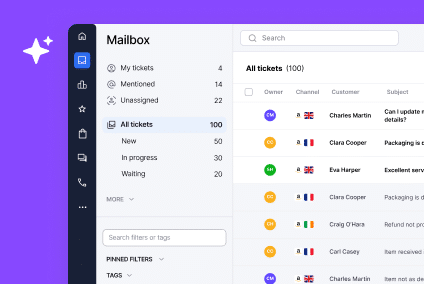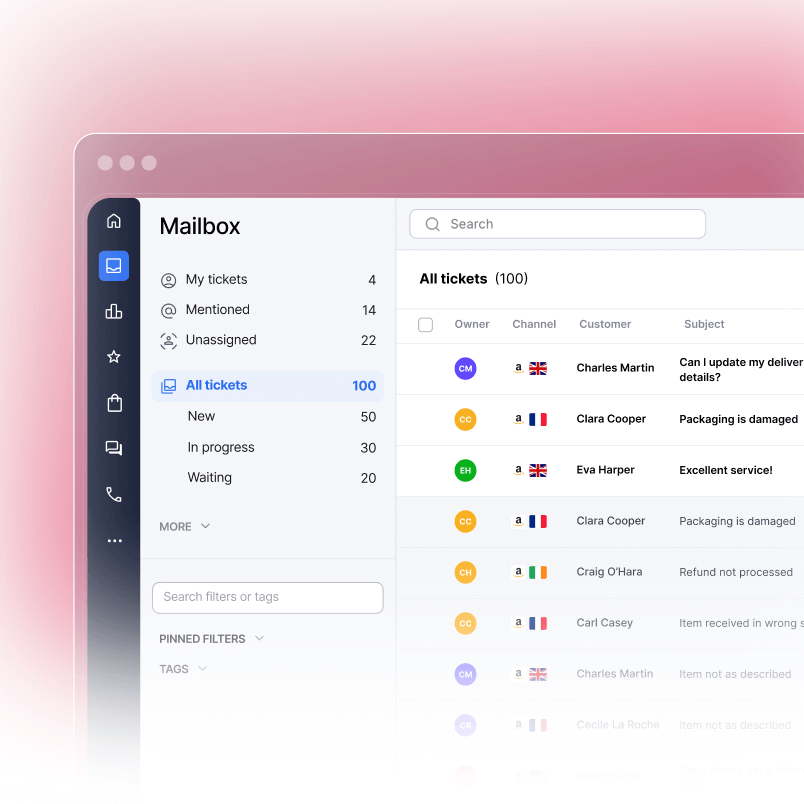You’ve probably noticed your inbox is a mess. Buyer messages from eBay mixed with customer emails from other channels. Manual message tracking. Order details scattered across tabs. And then that sinking feeling when a negative feedback appears because you missed a message or took too long to respond.
Here’s the truth: generic helpdesk software wasn’t built for eBay’s unique marketplace environment. It doesn’t understand order numbers as the foundation of every conversation. It doesn’t sync with eBay’s API. It doesn’t know your TOS rules. And it definitely doesn’t protect your seller rating when things go wrong.
This guide explains why eBay sellers need purpose-built ticketing software, not cobbled-together alternatives. We’ll walk through the limitations of generic tools, what makes eBay-specific platforms different, and how to pick the right one for your business.
The Limitations of Generic Helpdesk Tools
Generic helpdesk platforms like Freshdesk or Zendesk handle support tickets well in general. But they don’t understand eBay. Here’s what breaks down when you try to force a square peg into a round hole.
Lack of Native eBay Integration
Generic tools often require Zapier or third-party connectors to communicate with eBay. This creates lag, sync errors, and constant configuration headaches. When a buyer sends a message on eBay, it might take minutes (or longer) to appear in your generic helpdesk. By then, you’re already behind.
eBay’s platform moves fast. Buyers expect responses within hours, not half a day. Native integration means messages appear instantly.
No Automatic Order Data Lookup
eBay ticket software should pull order details automatically: item descriptions, purchase dates, shipping status, return window status, and payment information. Generic tools make you manually search for this information or copy-paste it into each ticket.
That’s not just slow. It’s a hidden time drain. On 50 messages a day, you’re losing hours to manual lookups. Your team gets frustrated. Response times slip.
Manual Message Triage and Routing
Generic helpdesks don’t understand eBay message types. A « item not received » inquiry looks the same as a « seller didn’t respond » complaint. Both get dumped into one inbox with no smart routing.
eBay-specific software recognizes message intent automatically and can route to the right team member based on product category, return status, or urgency. This keeps your workflow organized and speeds resolution.
Risk of Terms of Service Violations
eBay has specific rules about how sellers can communicate with buyers. Asking for contact information outside the platform, offering discounts for external reviews, or sending unsolicited promotional messages can trigger account warnings or suspensions.
Generic helpdesk templates don’t understand these rules. Your team is left to manually check every response against eBay’s policies. One mistake from a new agent and your account is flagged. Review eBay’s selling policies overview to understand the full scope of communication requirements.
SLA Tracking is Built-In
eBay seller performance depends on response rates and time-to-resolution metrics. Generic tools don’t have built-in timers for eBay’s specific response windows. You manually track deadlines in spreadsheets or miss them entirely. This directly impacts your seller rating. To understand the full impact of SLA management, read about agent SLA tracking software for marketplaces. For official details on how eBay measures performance, check out eBay’s seller standards policy.
What Makes eBay Ticketing Software Different
Purpose-built eBay ticketing software bridges the gap between general helpdesk features and marketplace-specific workflows. Here’s what separates them.
Deep eBay API Integration for Real-Time Order Sync
True eBay ticketing software connects directly to eBay’s API. Every buyer message syncs instantly. Order data loads automatically. Return statuses update in real time. No third-party connectors. No delays.
When a customer writes, « I haven’t received my item, » the system shows you exactly when the item shipped, current tracking information, and delivery estimates. You respond in seconds with accurate data.
Message Threading by Transaction ID
Every buyer message links directly to its transaction ID on eBay. All communication about order #12345 stays grouped together, even across multiple buyer inquiries. No more scrolling through 50 tabs to piece together conversation history.
This simple feature saves 20-30 minutes per seller per day.
Pre-Approved Templates That Follow eBay Rules
eBay-specific platforms include templates for common buyer scenarios: return requests, item condition questions, shipping inquiries. Each template is written to comply with eBay’s communication policies. Your team doesn’t need to reinvent the wheel or worry about policy violations.
New agents can respond confidently on day one because they’re using pre-vetted language.
Real-Time Status Updates on Returns, Disputes, and Delivery
Your software automatically flags when a return window is closing, a dispute is filed, or a shipping delay occurs. You don’t have to check eBay manually. The system alerts you. This lets you reach out proactively and resolve issues before they become negative feedback.
Built-In SLA Timers and Automatic Escalations
eBay requires sellers to respond to messages within 24-48 hours, depending on the inquiry type. eBay ticketing software includes automatic SLA timers specific to eBay’s requirements. If a ticket approaches its deadline without response, the system flags it or escalates it to a manager.
This eliminates missed response deadlines.
How Specialized Tools Improve Seller Performance
The right eBay ticketing platform doesn’t just organize your workflow. It directly impacts your business metrics.
Faster Response Times Equal Higher eBay Ratings
eBay’s algorithm rewards sellers who respond quickly. Faster response times improve your seller rating and make your listings appear higher in search results. When your team can access all ticket information at once and use pre-approved templates, response time drops by 30-50%.
One seller we’ve seen reduced average response time from 6 hours to under 2 hours after switching to specialized eBay software. Research shows that 52% of customers stop purchasing from a company due to slow response times, while 89% of consumers say a quick response to an initial inquiry influences their purchase decision. eBay’s algorithm heavily factors response speed into seller performance ratings. 65% of customers expect a faster response time than they did five years ago, putting pressure on sellers to improve their response rates consistently.
Lower Return and Cancellation Rates
Fast, accurate communication prevents misunderstandings. When you can immediately address a buyer’s concern with specific order data and helpful information, they’re less likely to open a return or cancel. The ability to proactively reach out about shipping delays or help with item questions reduces friction before it becomes a return. Proactive customer service matters: 87% of customers appreciate proactive solutions, boosting satisfaction and loyalty. When you catch issues early through fast messaging, you prevent returns, refunds, and the negative feedback that follows. Your ability to offer solutions before a buyer files a return directly impacts your bottom line and seller rating.
Easier Team Collaboration on High-Ticket Volumes
When you’re processing 50 or 100 messages a day, manual coordination falls apart. Who’s handling which ticket? Did someone already respond to that buyer? Is this a duplicate inquiry?
eBay ticketing software assigns tickets to team members, shows status in real time, and prevents duplicate responses. Everyone knows exactly what’s in progress and what’s been resolved.
Fewer Policy Violations Through Pre-Approved Communication
Your first violation warning from eBay is stressful. Your second warning could mean account suspension. Pre-built, TOS-compliant templates eliminate the guessing game. Your entire team communicates safely within eBay’s rules, even under pressure.
Key Features to Look for in eBay Ticketing Software
Not all « eBay-friendly » software is built equal. Here’s what matters.
Native eBay Integration, Not Zapier-Based
Look for platforms that built their own eBay API connection, not ones that rely on third-party automation tools like Zapier. Native integration means faster syncs, fewer errors, and better support when something breaks.
Ask vendors directly: « Do you have a native eBay API integration, or do you use Zapier? » The answer tells you everything.
Order ID-Based Message Threading
Every single conversation should be organized by the eBay transaction ID, not by buyer username or message date. This keeps related inquiries grouped and prevents you from losing context.
TOS-Compliant Message Templates
Look for platforms that specifically mention eBay compliance in their templates. They should cover common scenarios: return inquiries, shipping updates, delivery delays, and item condition questions.
Bonus: the platform should allow your team to easily create new templates and flag them for compliance review.
Automatic Routing by Product, Category, or Urgency
The system should be smart enough to send item-condition questions to your product specialists, return requests to your returns team, and delivery disputes to your shipping expert. This speeds resolution and reduces errors.
SLA Breach Alerts and Performance Dashboards
You need visibility into whether your team is meeting eBay’s response time requirements. The software should show real-time dashboards for response times, resolution times, and individual agent performance. When an SLA is about to breach, the system alerts you immediately.
Top Tools Built for eBay Seller Support
Here are the platforms that actually understand eBay sellers’ needs.
eDesk
eDesk was built from the ground up for marketplace sellers. It offers deep eBay integration (and Amazon, too, if you sell cross-channel). Order data syncs in real time. Message threading is automatic. SLA tracking is built in. The platform includes compliance-focused templates and team assignment features.
Best for: Sellers across multiple channels who want one unified inbox. eDesk handles eBay, Amazon, Shopify, and other platforms under one roof. Learn more about how to optimize your customer support strategy with tools designed for eCommerce by reading about AI-powered ticketing support for eCommerce success.
ChannelReply
ChannelReply acts as a bridge, connecting eBay messages to industry-standard helpdesk platforms like Zendesk or Freshdesk. If you’re already invested in one of those systems but want eBay-specific features, this adds a layer on top.
Best for: Sellers who must use Zendesk or Freshdesk but need better eBay functionality.
3Dsellers
3Dsellers focuses specifically on eBay messaging and automation. It’s lightweight and affordable, making it a good entry point for newer sellers or small teams.
Best for: Budget-conscious sellers who want eBay-specific ticketing without extra channels.
Replyco
Replyco specializes in eBay workflows and includes built-in automations for common scenarios. It’s been around since the early days of eBay seller tools.
Best for: Sellers who prioritize eBay-only ticketing with established workflow automations.
Feature Comparison
| Tool | Native eBay Integration | Multi-Channel Support | SLA Tracking | Best For |
| eDesk | Yes | Yes (5+ channels) | Yes | Multi-channel sellers |
| ChannelReply | Yes | Bridge only | Via Zendesk/Freshdesk | Existing Zendesk/Freshdesk users |
| 3Dsellers | Yes | No | Yes | Budget eBay-only sellers |
| Replyco | Yes | No | Yes | eBay specialists |
When to Upgrade from Manual or Generic Systems
You don’t need eBay ticketing software if you get one or two buyer messages a week. But here’s when it becomes essential. For a detailed understanding of when your seller performance level changes, review eBay’s seller levels and performance standards.
Daily Message Volume Exceeds 20-30
Once you’re handling more than 20-30 buyer messages daily, manual systems collapse. You’ll miss messages, duplicate responses, and blow SLA deadlines regularly. At this volume, you need automation and smart routing.
Selling Across Multiple Marketplaces
If you sell on eBay and Amazon (or eBay, Amazon, and Shopify), managing three separate inboxes is chaos. A unified ticketing system with multi-channel support saves hours and eliminates cross-channel mistakes.
Repeated SLA Violations or Negative Feedback Trends
If your seller rating is slipping or you notice negative feedback mentioning slow responses, your current system isn’t cutting it. This is a warning sign. Moving to eBay ticketing software can turn that around within weeks.
Slow Agent Response or Lack of Message Visibility
If your team doesn’t know which tickets are assigned to them or what happened in previous conversations, you have a visibility problem. Specialized software creates transparency and accountability.
New Team Members Requiring Constant Oversight
Every new hire needs training on eBay policies and your communication standards. Pre-built templates and automated compliance checks onboard team members faster and reduce errors from day one.
Getting Started with eBay Ticketing Software
Switching platforms takes work, but the payoff is clear. Here’s how to make the transition smooth. For deeper insights on implementing proper helpdesk workflows, check out our guide on the best eCommerce helpdesk software for your business needs.
Audit Your Current Message Volume
Count your average daily buyer messages for the last 30 days. This tells you which platform tier you actually need. Over-investing in features you won’t use wastes money. Under-investing means you’ll outgrow the tool in six months.
Check Integration Capabilities
Contact vendors and ask exactly what integrates. Does it sync with your accounting software? Your inventory management platform? Your fulfillment service? The more tools that connect, the less manual work your team does.
Run a Pilot with a Small Team
Don’t switch your entire operation on day one. Let a few team members test the new platform while others stay on the old system. This lets you catch configuration issues and train people gradually.
Migrate Conversation History (If Possible)
Some platforms allow you to import your message history from the old system. This preserves context for ongoing disputes or returns. Ask your new vendor whether this is possible before signing up.
Set Up Templates and Workflows Before Going Live
Before your whole team switches over, build out your message templates, set up auto-routing rules, and configure SLA timers. The first week with new software is easier when everything is already configured.
The Real Cost of Staying with Generic Helpdesks or Manual Systems
Here’s what it really costs to stay where you are.
Hidden Time Drain
Your team spends hours on manual lookups, tab-switching, and message reorganization. That’s not obvious until you switch platforms and realize you’ve freed up 10-15 hours per week per person.
Missed Response Deadlines
Every missed SLA deadline damages your seller rating. A few missed deadlines this month might seem acceptable. But eBay’s algorithm compounds the damage over time. A few percentage points drop in your seller rating means fewer sales, less visibility, and lower revenue. In 2024, eBay sellers worldwide collected 74.7 billion dollars in gross merchandise value. When your seller rating drops even slightly, your share of that opportunity shrinks. Missing response deadlines directly impacts your access to best placement features and advertising opportunities.
Higher Return Rates
When you can’t address buyer concerns quickly or accurately, return rates climb. Returns cost time, reduce your seller rating, and eat into profit margins.
New Hire Turnover
Support jobs are stressful. When you make your team work with disorganized systems, outdated tools, and ambiguous policies, turnover climbs. New hire churn is expensive.
Making the Switch
You don’t need to stay stuck in a system that’s costing you time, money, and peace of mind. Thousands of eBay sellers have already switched to specialized ticketing software and seen immediate improvements in response times, seller ratings, and team morale. Brands that prioritize customer experience see a 4-8% increase in revenue compared to their competitors.
Start by auditing your current workflow. If you’re handling 20+ messages daily, if you’re seeing negative feedback about slow responses, or if your team is frustrated with manual systems, it’s time to explore options. Check out our guide on customer service automation to learn more about how specialized tools can save your team time.
The right eBay ticketing software will give you back hours every week, protect your seller rating, and let your team focus on actually helping customers instead of drowning in inbox management.
Your seller rating and your team’s sanity are worth the switch.
FAQs
What is eBay ticketing software?
eBay ticketing software is customer support software built specifically for eBay sellers. It handles buyer messages, automatically pulls order data from eBay, organizes conversations by transaction ID, and includes compliance templates. Unlike generic helpdesks, it understands eBay’s unique workflows and requirements.
Can I use Zendesk or Freshdesk for eBay?
You can use them with a connector like ChannelReply or Zapier, but they weren’t built for eBay. You’ll lose eBay-specific features like automatic order data lookup, native SLA tracking, and compliance templates. They work, but they’re slower and require more manual effort than purpose-built platforms.
What’s the best tool for managing eBay buyer messages?
The best tool depends on your needs. eDesk is best for multi-channel sellers. ChannelReply is best if you must use Zendesk or Freshdesk. 3Dsellers and Replyco are best for eBay-only sellers who want affordability and specialization. Start by considering your channel strategy and daily message volume.
Does eBay penalize slow support responses?
Yes. eBay’s algorithm tracks your response time and factors it into your seller rating. Slow responses harm your visibility in search results and can trigger warnings if they become chronic. The platform rewards sellers who respond within 24-48 hours consistently. Learn more about how eBay evaluates your performance by reading eBay’s service metrics and peer benchmarking policy.
How much time does eBay ticketing software save?
On average, sellers report saving 10-15 hours per week per team member by switching from manual systems or generic helpdesks. This comes from faster message lookups, reduced tab-switching, eliminated duplicate work, and streamlined team collaboration.
Is there a learning curve with new eBay ticketing software?
Most purpose-built platforms have minimal learning curves because they’re designed specifically for seller workflows. Team members typically become productive within a few days. Tools with built-in templates reduce training time even further.
Can eBay ticketing software help prevent negative feedback?
Absolutely. Faster response times, proactive communication, and accurate information prevent many buyer issues from escalating to negative feedback. SLA alerts help you catch problems before they reach the feedback stage.




